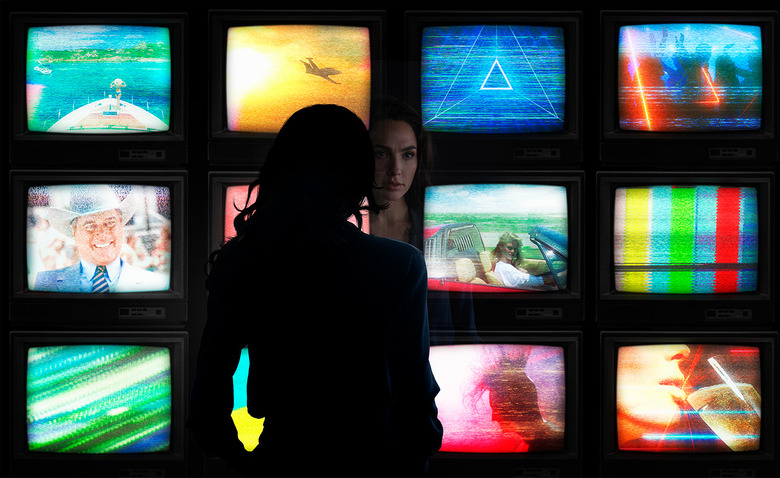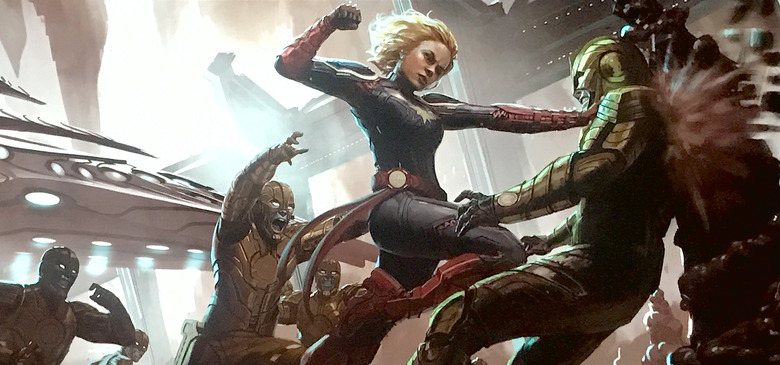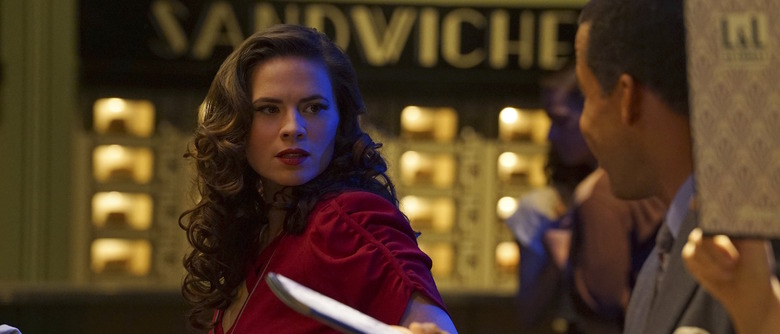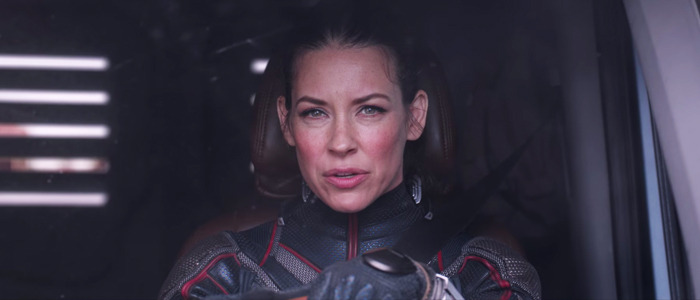Why Are So Many Female Superheroes Stuck In The Past?
Wonder Woman is an icon for our age. Strong, empowering, complex, and compassionate, Gal Gadot's Diana of Themyscira is the heroine that so many little girls have been dressing up as and looking up to. So why is she always stuck in the past?
For her first two solo movies, Wonder Woman and the upcoming Wonder Woman 1984, Diana and her superheroics reside firmly in past decades. And yes, they're prequel films, and yes, she's hundreds of years old so you can really place her solo movies whenever you want them. But Wonder Woman's solo movies getting consistently set in the past is a problem she shares with many of the other major female superheroes today.
When it comes to Wonder Woman, Captain Marvel, and reports about the potential Black Widow prequel film, Hollywood can't seem to competently deal with female superhero stories in the modern age. And as much as we love seeing Gal Gadot in a suffragette suit or Brie Larson rocking the Rachel hair, there's something fishy about sending many of these major female superheroes back to the past.
Diana, Princess of the Past
We were first introduced to Gal Gadot's Wonder Woman in 2016's Batman v Superman: Dawn of Justice, a film that takes place in some warped present day. But she was only a supporting character who barely appeared for more than 15 minutes. It was an explosive debut that made fans all the more eager for her solo movie, Wonder Woman, which would hit theaters a year later. In Patty Jenkins' film, we were introduced to Diana again, this time a young and naïve Themysciran who ventures out into the world of man for the first time — in 1918.
For her first solo movie, it makes sense that Diana's origin story would take place in the decades before Batman v Superman: Dawn of Justice — even if the movie doesn't make significant strides to really explain why she was MIA for nearly a century. And it was smart to tie Wonder Woman's first foray out into the world of man with World War I — a fresh twist on William Moulton Marston's first Wonder Woman issues set in World War II.
But perhaps one of the biggest reasons Wonder Woman is set in the past is so we can see her utopian feminist values clash with the outrageously patriarchal society of the 1910s. The war cabinet doesn't allow woman! Ladies can only wear skirts! Men are sexist pigs! Everyone vastly underestimates Diana, which makes it all the more triumphant when she proves them wrong! It's feminism made digestible: you get all the principles of feminism with none of the ugly politics of today's modern-day feminist movement simply because the men are so clearly in the wrong.
But it worked for what Wonder Woman was trying to do. By setting Wonder Woman in the past, Patty Jenkins kept the solo film in its own corner of an increasingly confusing and dark DCEU. But interestingly, even as Warner Bros. positioned Wonder Woman as a turning point for the DCEU and the start of a new, lighter cinematic universe, the Wonder Woman sequel remained stuck in its little corner in the past, this time in 1984.
In Wonder Woman 1984, we meet Diana at the tail end of yet another war. We don't know many details about the sequel, but we know that Diana is living an unobtrusive life during the Cold War, perhaps as an art historian who doubles as Wonder Woman like we see her doing in modern day. So why couldn't we just see her doing that in modern day? The '80s are a significantly better time for women, having just come off the second-wave feminist movement, but it was also an era where major movies could get away with stealing women's underpants for the whimsy or raping women for the joke. "Girl power" was just on the tip of everyone's lips, but not for many years — for now, Diana could get away with being underestimated and probably with dealing with sexist male coworkers at the workplace. "It was the '80s! It was a different time!" is something we hear a lot in the excuses of men who are the focus of the Me Too movement, which is why it feels like such an easy cop-out to set the Wonder Woman sequel in the past again.
Captain Marvel’s All That
Captain Marvel's setting in the '90s is even more mysterious. It was so recent that it makes you wonder why they simply couldn't push it forward a few more decades. But then you realize that the '90s were more than 20 years ago.
From a storytelling standpoint, it makes some kind of sense. Marvel Studios President Kevin Feige has said that Captain Marvel is the most powerful superhero in the MCU, one who could run circles around Thor or Doctor Strange. Putting her in the modern day as a newly emerged superhero would render the rest of the Avengers irrelevant — and we can't have that, can we?
Sarcasm aside, it's too early to tell why Captain Marvel is set more than a decade before the current timeline of the MCU. It's not the first time Marvel has placed its heroes in the past to expand its world — Captain America being the prime example. Captain Marvel will reportedly deal with the introduction of the Skrulls, an alien race of shapeshifters who have terrorized the Marvel heroes in the comics for years and could play a significant part in the cosmic era of the MCU. And then the end credits of Avengers: Infinity War hint that Captain Marvel may be Nick Fury's ace come Avengers 4.
But it doesn't bode well for the future of women superheroes in the MCU that the studio's first major solo female superhero movie is set in the past.
The Peggy Problem
All right, Peggy Carter is not technically a superhero, but she she might as well be one. And as Marvel's first foray into a female-led title, the ABC series Agent Carter essentially created the formula for how they would approach their feature film venture with Captain Marvel (and even to an extend DC's Wonder Woman).
Introduced in Captain America: The First Avenger, Hayley Atwell stole the scenes as Steve Rogers' superior officer overseeing his transformation into super soldier. A rare female agent of the Strategic Scientific Reserve and an even rarer believable Marvel love interest, Peggy was a paragon for what a strong female character in the MCU could be. She was so compelling that she earned her own TV show. Agent Carter ran for two critically acclaimed seasons on ABC and followed the strong-willed SSR agent as she overcame — what else? — the sexism of her colleagues and her oppressively patriarchal society. In the 1940s, Peggy Carter took all manner of workplace harassment and gross misogynistic comments, and proved everyone wrong time and again.
Like Wonder Woman and the 1910s, Peggy Carter dealt with the worst sexism that the 1940s could offer — separating this feminist hero from the unpleasant politics of today. Easy.
When Will The Women Go Back to the Future?
It's only on TV that we've seen female superheroes exist in our present. Netflix's Jessica Jones is as real and today as you can get, while the CW's Supergirl admittedly exists in a '90s rom-com version of present-day, but present-day it is. TV has always been strides ahead of the movie industry when it comes to championing diversity. And perhaps they're a few decades ahead too.
The only Marvel female superhero set in the modern day who appears in a movie title is Evangeline Lilly's the Wasp in Ant-Man and the Wasp — and she only gets double billing with Paul Rudd's Ant-Man. And the future doesn't look much brighter: Black Widow starring Scarlett Johansson will reportedly be a prequel — which isn't much of a consolation for the fans who have demanded a Black Widow solo movie for nearly a decade.
Perhaps Marvel and Warner Bros. don't want to repeat the embarrassing failures of the modern-day set female-led Elektra and Catwoman. Or perhaps we're still just at the beginning of the era of solo female superhero movies, and it will take a few more decades to bring them back to the present. But whatever the case, this is a curious trend for female superhero movies, but hopefully one that won't stick around for long.




